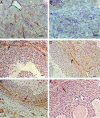Comparison of Allotransplantation of Fresh and Vitrified Mouse Ovaries to The Testicular Tissue under Influence of The Static Magnetic Field
- PMID: 28836412
- PMCID: PMC5570414
- DOI: 10.22074/cellj.2017.4513
Comparison of Allotransplantation of Fresh and Vitrified Mouse Ovaries to The Testicular Tissue under Influence of The Static Magnetic Field
Abstract
Objectives: The aim of this study was to investigate the effects of static magnetic field (SMF) during transplantation of the ovarian tissue into the testis.
Materials and methods: In this experimental study, ovaries of 6- to 8-week-old female Naval Medical Research Institute (NMRI) mice were randomly divided into four groups: i. Fresh ovaries were immediately transplanted into the testicular tissue (FOT group), ii. Fresh ovaries were exposed to the SMF for 10 minutes and then transplanted into the testicular tissue (FOT+ group), iii. Vitrified-warmed ovaries were transplanted into the testicular tissue (VOT group), and iv. Vitrified-warmed ovaries were transplanted into the testicular tissue and the transplantation site was then exposed to the SMF for 10 minutes (VOT+ group).
Results: The lowest percentages of morphologically dead primordial follicles and the highest percentages of morphologically intact primordial follicles were seen in the FOT+ group (4.11% ± 2.88 and 41.26% ± 0.54, respectively). Although the lowest significant percentage of maturation, embryonic development and fertility was observed in the VOT group as compared to the other groups, the difference in the fertility rate was not significant between the VOT and VOT+ groups. Estrogen and progesterone concentrations were significantly higher in the FOT+ group than those of the control mice.
Conclusions: It is concluded that, exposure of the vitrified-warmed ovaries to SMF retains the structure of the graft similar to that of fresh ovaries.
Keywords: Apoptosis; Magnetic Field; Mice; Transplantation; Vitrification.
Copyright© by Royan Institute. All rights reserved.
Conflict of interest statement
There is no conflict of interest in this study.
Figures





Similar articles
-
Function of vitrified mouse ovaries tissue under static magnetic field after autotransplantation.Vet Res Forum. 2017 Summer;8(3):243-249. Epub 2017 Sep 15. Vet Res Forum. 2017. PMID: 29085613 Free PMC article.
-
Follicle Development in Grafted Mouse Ovaries after Vitrification Processes Under Static Magnetic Field.Cryo Letters. 2017 May/Jun;38(3):166-177. Cryo Letters. 2017. PMID: 28767739
-
Ovarian injury during cryopreservation and transplantation in mice: a comparative study between cryoinjury and ischemic injury.Hum Reprod. 2016 Aug;31(8):1827-37. doi: 10.1093/humrep/dew144. Epub 2016 Jun 16. Hum Reprod. 2016. PMID: 27312534
-
Optimal vitrification protocol for mouse ovarian tissue cryopreservation: effect of cryoprotective agents and in vitro culture on vitrified-warmed ovarian tissue survival.Hum Reprod. 2014 Apr;29(4):720-30. doi: 10.1093/humrep/det449. Epub 2013 Dec 22. Hum Reprod. 2014. PMID: 24365801
-
Diseases of the Ovaries: Their Diagnosis and Treatment.Br Foreign Med Chir Rev. 1865 Oct;36(72):360-367. Br Foreign Med Chir Rev. 1865. PMID: 30164134 Free PMC article. Review. No abstract available.
Cited by
-
Auto-transplantation of whole rat ovary in different transplantation sites.Vet Res Forum. 2017;8(4):275-280. Epub 2017 Dec 15. Vet Res Forum. 2017. PMID: 29326784 Free PMC article.
References
-
- Oakley CS, Welsch MA, Zhai YF, Chang CC, Gould MN, Welsch CW. Comparative abilities of athymic nude mice and severe combined immune deficient (SCID) mice to accept transplants of induced rat mammary carcinomas: Enhanced transplantation efficiency of those rat mammary carcinomas that have elevated expression of neu oncogene. Int J Cancer. 1993;53(6):1002–1007. - PubMed
-
- Donnez J, Dolmans MM, Demylle D, Jadoul P, Pirard C, Squifflet J, et al. Livebirth after orthotopic transplantation of cryopreserved ovarian tissue. Lancet. 2004;364(9443):1405–1410. - PubMed
-
- Meirow D, Levron J, Eldar-Geva T, Hardan I, Fridman E, Zalel Y, et al. Pregnancy after transplantation of cryopreserved ovarian tissue in a patient with ovarian failure after chemotherapy. N Engl J Med. 2005;353(3):318–321. - PubMed
-
- Wang H, Mooney S, Wen Y, Behr B, Polan ML. Follicle development in grafted mouse ovaries after cryopreservation and subcutaneous transplantation. Am J Obstet Gynecol. 2002;187(2):370–374. - PubMed
-
- Callejo J, Salvador C, Miralles A, Vilaseca S, Lailla JM, Balasch J. Long-term ovarian function evaluation after autografting by implantation with fresh and frozen-thawed human ovarian tissue. J Clin Endocrinol Metab. 2001;86(9):4489–4494. - PubMed
LinkOut - more resources
Full Text Sources
